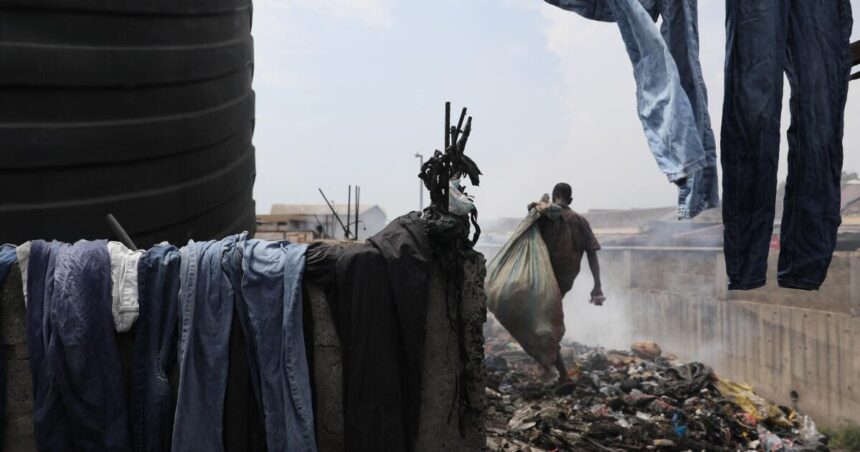Global criticism of fast fashion’s waste, labour exploitation and carbon emissions has done little to slow the industry, but new laws could change the flood of products like $2.99 floral jumpers, $4.26 children’s T-shirts and $4.88 tank tops.
The term “fast fashion” emerged in the 1990s with Zara, a European company selling affordable runway-inspired styles, and came to define trendy, low-cost clothing that was worn and then thrown away.
This business model has become popular among consumers and brands who want to keep inventory low, anticipate customer demand, and take advantage of a flexible supply chain to respond quickly.The latest example of this model is exemplified by the hugely successful Chinese e-commerce platforms Shein and Temu.
Shen Lu, professor and dean of the Graduate School of Fashion and Apparel Studies at the University of Delaware, said traditional retailers might offer 1,000 styles a year. Compare that to Zara and H&M, the first generation of fast-fashion brands that produce about 20,000 items a year. She added that SHEIN, which has been labeled “ultra-fast fashion,” produces 1.5 million styles a year.
The global fashion industry is estimated to be worth $1.7 trillion, and clothing production and the number of clothes purchased per person have increased by 60%, according to consulting firm McKinsey & Company. At the current pace, McKinsey predicts that consumption of clothing and footwear will grow from 62 million tonnes in 2019 to 102 million tonnes in 2030, “the equivalent of more than 500 billion T-shirts.”
As clothing prices plummet (a few months ago, McKinsey reported that Shein’s products cost $14, H&M’s $26, and Zara’s $34), customers are becoming less hesitant to throw away their clothes. McKinsey reports that less than 1% of fashion textiles are recycled, and three out of every five pieces of clothing are incinerated each year.
But as fast fashion has grown in popularity, so has the backlash against it, drawing the ire of environmental groups, labor activists and lawmakers in Europe and the U.S. “The debate on fast fashion is rapidly moving from the traditional business side to the policy side,” Lu said.
Recent legislation in several countries aims to curb the fashion industry’s environmental impact. It is estimated that the fashion industry emits more global warming greenhouse gases than international aviation and maritime shipping combined. McKinsey estimates that the fashion industry is responsible for 3-8% of global greenhouse gas emissions, and that this could increase by a further 30% by 2030.
France has led the effort to combat fast fashion: In March, the lower house passed a bill that would ban advertising for fast-fashion products and impose fines for each garment sold. France has also proposed a European Union-wide ban on the export of used clothing to curb the waste of cheap goods that end up in landfills overseas.
New York state lawmakers have drafted a bill that would require major fashion brands operating in the state to map and disclose their supply chains to avoid labor exploitation and environmental damage.
According to McKinsey’s State of Fashion 2024 report, 87% of fashion executives surveyed believe sustainability regulations will impact their business this year. “The landscape is changing,” Lu said. “These regulations, along with changes in consumer behavior, will put a lot of pressure on fast fashion brands.”
SHEIN, which uses predictive analytics to determine which clothing designs will sell best, claims it has a less wasteful business model than traditional retailers because it only produces what customers order.
Still, the companies most associated with the phenomenon are working to diversify their offerings to avoid the fast fashion label and its negative connotations.
A new third-party marketplace allows Shein customers to find second-hand luxury items on the site. Once a pioneer of fast fashion, Zara has pledged to make all of its products from sustainable, organic or recycled materials by 2025, and to introduce more high-quality, value-for-money items into its product lines.
But the impact of fast fashion is not going away: it has transformed the global clothing supply chain as traditional retailers adopt practices to give them more speed and flexibility.
According to Raymond Wong, a professor at the School of Logistics and Ocean Sciences at the Hong Kong Polytechnic University, before the advent of fast fashion, it took about two months to produce a standard garment. Now, fast fashion can produce an item from conception to delivery in less than two weeks.
And as production capacity accelerates, so too is the lifecycle of the clothes retailers sell: Whereas clothing collections have traditionally been divided into seasons, fast-fashion brands can now release at least one new collection per month, Wong said.
And brands are learning that being nimble pays.
Fast fashion companies’ profit margins are generally higher than traditional retailers’ because they prioritize sales volume and low-cost production, Wong said. Keeping inventory low also means they don’t have to offer steep discounts to get rid of unsold goods.
“That’s the philosophy of fast fashion retailers: if you can get products on the shelves a day earlier, you increase the possibility and probability of selling more,” Wong said.
More flexible production cycles mean brands work with many more vendors, manufacturers and suppliers than before, making it more difficult to assess violations of labor and environmental standards in the supply chain.
Sanchita Saxena, a professor at the University of California, Berkeley, who studies labor and garment supply chains in Asia, said while more brands are trying to become more sustainable, cost projections make it difficult for suppliers who are losing money on orders they do receive to take action.
The impact of fast fashion is “terrible for workers because the cycles are so fast and the delivery times are so short that it’s impossible for humans to produce the quantities of goods needed,” Saxena said, “but workers are under incredible pressure to do so, and there’s constant pressure on prices.”
Despite concerns about the negative impacts of fast fashion and sustainability efforts, experts say consumers alone cannot have a significant impact on how clothing supply chains adapt.
“Consumers have expressed a desire to make more ethical and responsible purchases, but they haven’t really demonstrated it at the scale needed to spur brands to act,” said Divya Demat, CEO of GoodOps, a San Francisco-based supply chain consulting firm.
Temu, a low-cost shopping app that became popular last year, was developed by Chinese e-commerce platform Pinduoduo to capitalize on the price sensitivity of American consumers.
According to McKinsey, 40% of U.S. consumers have shopped at Shein or Temu in the past 12 months, and many of the survey respondents said they intend to buy more from these fast fashion brands in the next two to three years.
“It’s a chicken-and-egg situation: brands say, ‘consumers want it, so let’s give it to them,’ and consumers say, ‘brands do it, so we’ll buy it,'” Saxena says. “Which comes first? I don’t know, but someone has to stop this vicious cycle.”
Special correspondent Hui-Yi Chiu in Taipei, Taiwan, contributed to this report.









